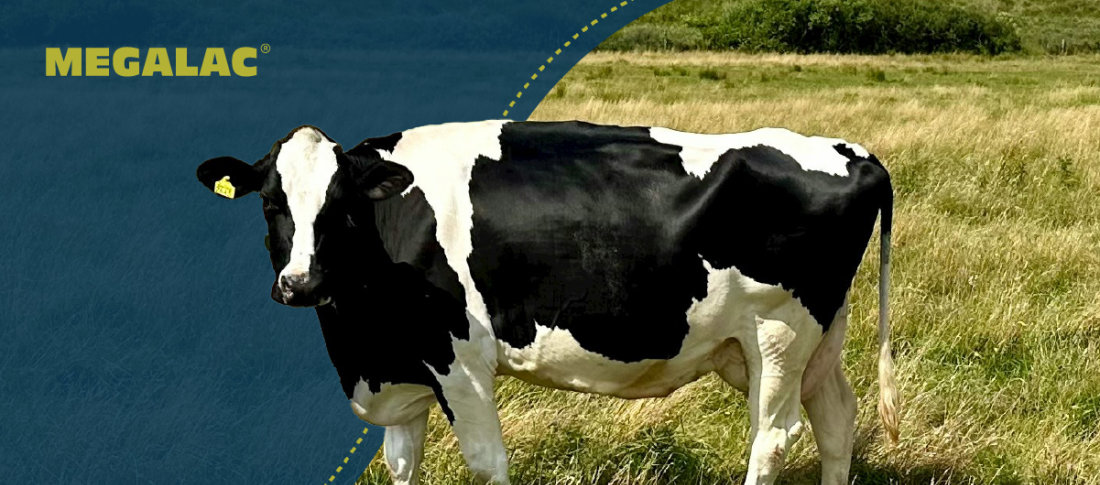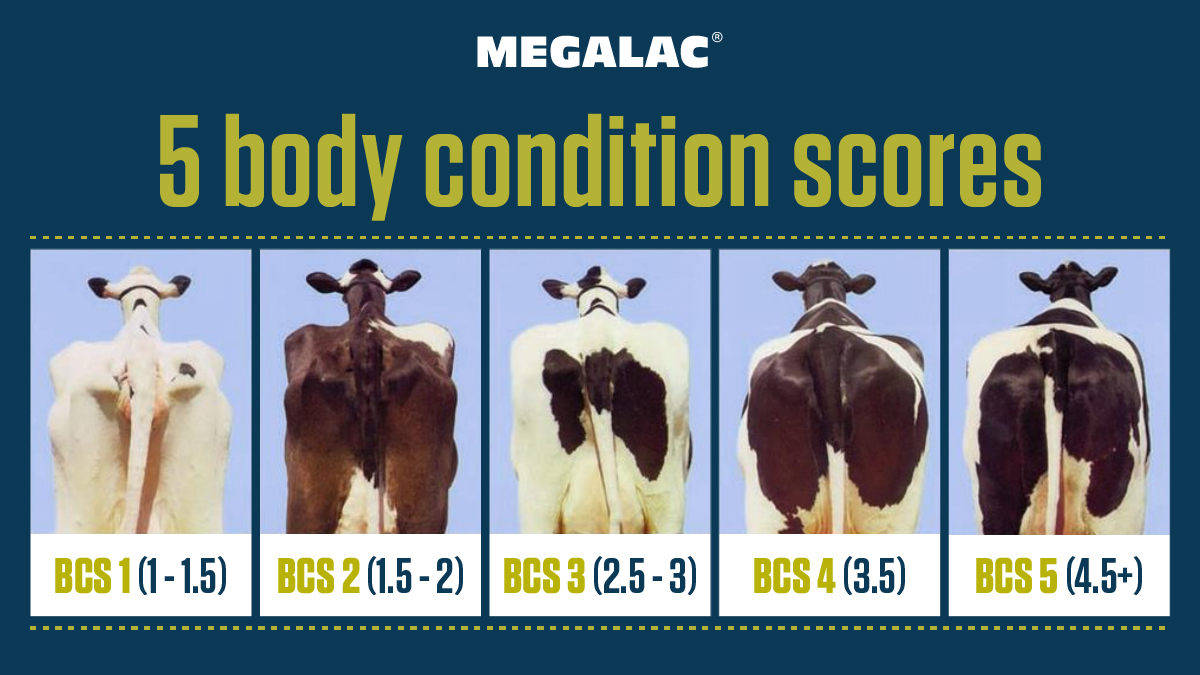Body condition scoring (BCS) is a technique that farmers often dismiss or overlook, but it’s a surprisingly effective barometer of each cow’s health, wellbeing, and future productivity.
Today, we're delving deep into the topic of BCS, giving you absolutely everything you need to know about the how, when and why of this technique - and how you can use it to help keep your cows in optimum condition.
What is body condition scoring?
Body condition scoring is a straightforward way of assessing how much body fat each of your cows has. It’s done via a hands-on assessment of the cow to determine the fat over the short ribs, thurl and tail head area. It’s often more accurate than weighing because it’s less affected by external factors like feed or water intake.
BCS is relatively simple to do and is an incredibly effective way to get an instant snapshot of your herd's nutritional status. Then you can take action before a cow’s health or performance is negatively affected.
Why should you implement body condition scoring into your routine?
The beauty of BCS lies in its simplicity and the wealth of benefits it offers.
Firstly, it provides valuable information about the energy reserves of your cows, helping you to make informed nutritional and management decisions that prevent dips in wellbeing, milk production, and fertility. Secondly, it helps detect potential health risks early on, allowing for early intervention.
Ultimately, BCS can help ensure your herd is in peak condition, and able to achieve consistently high milk production, which helps you maintain a sustainable and profitable farm.
How to body condition score cows
Body condition scoring is carried out by a hands-on assessment of the amount of flesh covering the loin, rump, and tail head areas. This gives you a score of one (underweight) to five (overweight), with the ideal score sitting around 2.5 to 3.5.
It’s a simple, step-by-step process that gets quicker with practice and experience.
- Make sure you have good light, and that the cow is relaxed and standing on a level surface
- Stand back to get an overall ‘big picture’ impression
- Feel the short rib area, paying particular attention to how the flesh follows the rib bones. Run your hand along the ribs to the backbone
- Move down the backbone, assessing the amount of fat between and around each vertebra
- Run your hand away from the backbone, along the ligament to the hook bone
- Assess the fat cover over the bone, and follow over the thurl to the pin bone
- Check the level of ‘dishing’ between the hook and pin bones
- Review the tail area, moving your hand up to the tail head to check fat coverage
- Look and feel the flesh coverage either side of the tail head and check if there are any folds of skin
Based on your observations and the feel of the cow, you then assign a score between 1 and 5.
Read more on how to body condition score.
What are the five body condition scores and what do they mean?
The five-point system is designed to be a consistent and objective measure of a cow’s body condition. After a hands-on assessment of the levels of fat covering the body, each cow is assigned a score:
- 1 to 1.5: the cow is too thin with no body reserves to draw on and needs immediate attention
- 1.5 to 2: the cow lacks reserves but may still be able to achieve peak productivity
- 2.5 to 3: this is the ideal condition - the cow is fit to cope with most stages of lactation
- 3.5 – the cow is at the higher end of the ideal and slightly overweight
- 4.5 - the cow is carrying too much fat

When should you body condition score cows and how often?
BCS is not an annual or random event and timing is crucial. For the most useful insights, it should be woven into your routine checks and done at least five times annually. The most common recommendation is to concentrate on five production milestones:
- Late lactation - 250 days in milk
- Dry-off
- Calving
- Post-calving examination - 21 days in milk
- Mid lactation
Early lactation is probably the most crucial time because a cow’s condition at this point has a knock-on effect on the whole of its subsequent production period. A cow within the optimum BCS in early lactation will be more likely to attain her potential peak yield, produce high quality milk and get back in calf according to plan.
Obtaining a further score in late lactation also enables you to act on any condition dropped during the lactation period and replenish any lost reserves to ensure each cow has enough energy stored for the following lactation. An assessment at this stage also gives you chance to intervene to help a cow with a higher than optimum BCS.
It doesn’t hurt to maintain regular BCS checks outside these periods too, to ensure your herd remains in optimal condition all year round.
What happens when a cow is over or under weight and condition?
Just like humans, cows that are carrying too much or too little weight can develop health problems. Overweight cows are more susceptible to metabolic problems and infections. They are also more likely to have difficulties during and after calving.
As for cows that are underweight, you can expect reduced milk production and low milk fat levels, partly because they lack the reserves to maintain production. Thin cows also frequently fail to conceive until they start to regain weight.
How to respond to body condition scoring
BCS isn’t just about numbers, it’s a lens through which you can view and enhance your farm's operational strategy.
If you detect low BCS (which can lead to reduced milk production, lower milk fat content, fertility issues, and increased disease risk), you can address this by ensuring your cows have access to plenty of water, evaluating their feed nutrition and using rumen-protected fat supplements like Megalac to bolster energy intake.
Early lactation is the best time to feed extra energy to your cows. Rumen-protected (bypass) fats (like Megalac) can be added to help meet energy requirements and should ideally target specific fatty acid profiles. Higher C18:1 (oleic acid) in the early lactation period will aid body condition and reduce loss of body condition score.
If a cow has a high BCS (which increases the risk of metabolic problems, infections, and calving difficulties), it shows you may need to scale back on energy intake during mid-late lactation and provide a low-energy ration with the right levels of protein, minerals, and vitamins during the dry phase.
Try to avoid causing overly rapid fluctuations in body condition and pay close attention to your cows during lactation, especially the latter stages and during the dry period.
Read more about how to maintain body condition through nutrition.
How to improve body condition scoring accuracy
As with any hands-on assessment, practice makes perfect. BCS needs to be done regularly by each member of your team to allow you to spot changes in each cow and act as a back-up to each other’s observations.
With advances in ag-tech, it’s also now possible to automatically measure BCS daily with the help of a BCS camera, which takes a 3D image of every cow’s back and monitors changes on your behalf. This can help removing the guesswork and risk of inaccuracies as well as potentially saving you time. Of course, not everyone has access to this sort of technology. And, sometimes, there’s just no substitute for good old-fashioned animal husbandry. You know your cows best!
So, there you have it: everything you need to know about BCS. Hopefully this has inspired you to add this handy technique to your herd management toolkit. It’s a significant step towards ensuring the health, productivity, and longevity of your herd.
Need a hand with your fat supplement calculations? Visit the Megalac website and try our free fat calculator to determine the optimum amount of fat to add to your dairy herd's diet.

